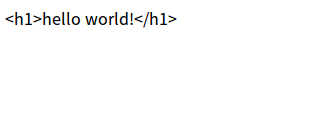ruby基础
1、 render
一下三种渲染方式的渲染结果是一样的:
render(:text=>"<h1>hello world!</h1>") render text:"<h1>hello world!</h1>" render html:"<h1>hello world!</h1>".html_safe
渲染结果:

render html:"<h1>hello world!</h1>"
渲染结果:

所以,在返回html时,如果不调用html_safe方法,html是无法正确解析的。
2、empty、blank
"somestring".empty?=>false
"".empty?=>true
nil.empty?=>NoMethodError: undefined method `empty?' for nil:NilClass(nil不支持empty方法)
nil.to_s.empty?=>true
" ".empty?=>false
" ".blank?=>true
nil.blank?=>true
3、nil
nil.nil?=>true
xx.nil?=>false(除了nil以外所有对象nil的结果都为false)
同理,除了!!nil=>false以外,所有的!!xx都为true,包括!!0=>true
4、unless
和if not相对应,if是在后面添加为真时执行,而unless是在后面条件返回值为false时才会执行
5、! bang
a = [42, 8, 17]
a.sort=>[8,17,42]
a=>[42,8,17] #执行sort方法时,对象a本身并没有发生变化
a.sort!=>[8,17,42]
a=>[8,17,42] #执行sort!方法时,对象a本身也变化了,这就是所谓的炸弹(bang!)方法
6、运算符
除法运算符, 1/10 ->0 9/10->0
在ruby中,两个整数类型的数字进行运算,得到的结果默认仍然是整数,而且没有四舍五入,所以在ruby中如果两个整数进行除法运算,而且希望可以得到精确值,应该想将其中一个数字转换为浮点数再进行运算,例如:1/10.0->0.1




